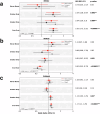Cross-ancestral GWAS identifies 29 variants across head and neck cancer subsites
- PMID: 41038832
- PMCID: PMC12491539
- DOI: 10.1038/s41467-025-63842-z
Cross-ancestral GWAS identifies 29 variants across head and neck cancer subsites
Abstract
Head and neck squamous cell carcinoma (HNSCC) includes diverse cancers arising in the oral cavity, oropharynx, and larynx, with the main risk factors being environmental exposures such as tobacco, alcohol, and human papillomavirus (HPV) infection. The genetic factors contributing to susceptibility across different populations and tumour subsites remain incompletely understood. Here we show, through a genome-wide association and fine mapping study of over 19,000 HNSCC cases and 38,000 controls from multiple ancestries, 18 genetic risk variants and 11 signals from fine mapping of the human leukocyte antigen (HLA) region, all previously unreported. rs78378222, a regulatory variant for TP53 is associated with a 40% reduction in overall HNSCC risk. We also identify gene-environment interactions, with BRCA2 and ADH1B variants showing effects modified by smoking and alcohol use. Subsite-specific analysis of the HLA region reveals distinct immune-related associations across HPV-positive and HPV-negative tumours. These findings refine the genetic architecture of HNSCC and highlight mechanisms linking inherited variation, immunity, and environmental exposures.
© 2025. The Author(s).
Conflict of interest statement
Competing interests: All Authors declare no competing interests.
Figures






Update of
-
Cross-ancestral GWAS identifies 29 novel variants across Head and Neck Cancer subsites.medRxiv [Preprint]. 2024 Nov 18:2024.11.18.24317473. doi: 10.1101/2024.11.18.24317473. medRxiv. 2024. Update in: Nat Commun. 2025 Oct 2;16(1):8787. doi: 10.1038/s41467-025-63842-z. PMID: 39606392 Free PMC article. Updated. Preprint.
References
-
- Sung, H. et al. Global Cancer Statistics 2020: GLOBOCAN estimates of incidence and mortality worldwide for 36 cancers in 185 countries. CA Cancer J. Clin.71, 209–249 (2021). - PubMed
-
- Thomas, S. J., Penfold, C. M., Waylen, A. & Ness, A. R. The changing aetiology of head and neck squamous cell cancer: a tale of three cancers?. Clin. Otolaryngol.43, 999–1003 (2018). - PubMed
-
- Hobbs, C. G. L. et al. Human papillomavirus and head and neck cancer: a systematic review and meta-analysis. Clin. Otolaryngol.31, 259–266 (2006). - PubMed
MeSH terms
Substances
Grants and funding
LinkOut - more resources
Full Text Sources
Medical
Research Materials
Miscellaneous

